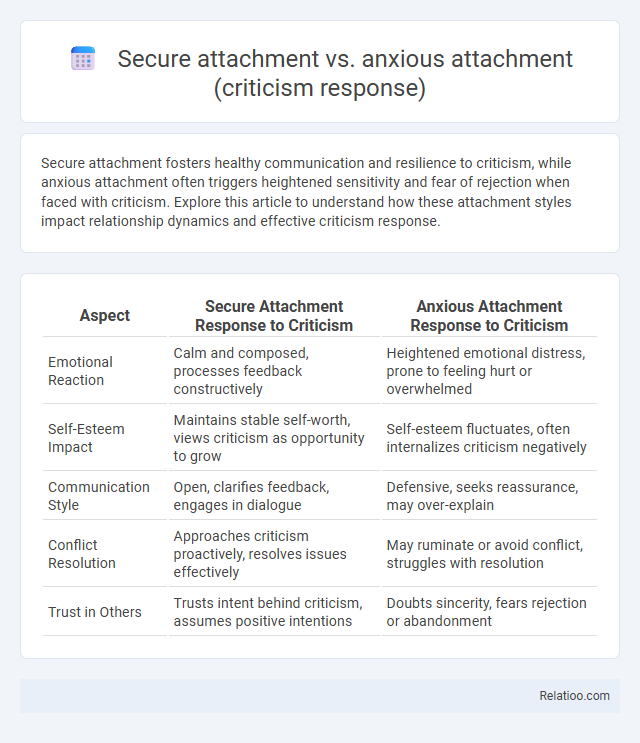Secure attachment fosters healthy communication and resilience to criticism, while anxious attachment often triggers heightened sensitivity and fear of rejection when faced with criticism. Explore this article to understand how these attachment styles impact relationship dynamics and effective criticism response.
Table of Comparison
| Aspect | Secure Attachment Response to Criticism | Anxious Attachment Response to Criticism |
|---|---|---|
| Emotional Reaction | Calm and composed, processes feedback constructively | Heightened emotional distress, prone to feeling hurt or overwhelmed |
| Self-Esteem Impact | Maintains stable self-worth, views criticism as opportunity to grow | Self-esteem fluctuates, often internalizes criticism negatively |
| Communication Style | Open, clarifies feedback, engages in dialogue | Defensive, seeks reassurance, may over-explain |
| Conflict Resolution | Approaches criticism proactively, resolves issues effectively | May ruminate or avoid conflict, struggles with resolution |
| Trust in Others | Trusts intent behind criticism, assumes positive intentions | Doubts sincerity, fears rejection or abandonment |
Understanding Secure and Anxious Attachment Styles
Understanding secure and anxious attachment styles reveals key differences in emotional regulation and relationship dynamics. Secure attachment is characterized by trust, effective communication, and emotional stability, fostering healthy connections. Your response to criticism varies significantly; those with anxious attachment may perceive feedback as personal rejection, while securely attached individuals view it as an opportunity for growth.
Key Differences Between Secure and Anxious Attachment
Secure attachment is characterized by trust, effective emotional regulation, and comfort with intimacy, enabling healthy relationship dynamics. Anxious attachment, in contrast, involves heightened sensitivity to rejection, fear of abandonment, and excessive need for reassurance, often leading to relationship instability. The key differences lie in emotional self-regulation and response to closeness, where secure attachment fosters confidence while anxious attachment drives insecurity and dependency.
Common Criticisms of Attachment Theory
Secure attachment is often contrasted with anxious attachment in attachment theory, yet common criticisms highlight that attachment styles, including secure attachment, may oversimplify complex human relationships by categorizing emotions and behaviors too rigidly. Critics argue that attachment theory underestimates cultural variations and situational factors influencing attachment behaviors, suggesting that secure attachment is not a fixed trait but a dynamic process shaped by ongoing interactions. Despite these criticisms, secure attachment remains a foundational concept for understanding emotional regulation and interpersonal trust, though it warrants integration with broader psychological and sociocultural contexts for a more nuanced application.
Evidence Supporting Secure vs Anxious Attachment
Research consistently demonstrates that secure attachment correlates with healthier emotional regulation, stronger interpersonal relationships, and higher overall well-being compared to anxious attachment, which is linked to heightened stress sensitivity and relationship instability. You benefit from adopting secure attachment behaviors, supported by neurobiological studies showing more effective stress responses and stable oxytocin regulation in securely attached individuals. This evidence underscores the long-term advantages of secure attachment in fostering resilience and emotional security.
The Impact of Parenting on Attachment Styles
Parenting plays a crucial role in shaping attachment styles, with secure attachment developing from consistent responsiveness and emotional availability by caregivers. Your ability to form healthy relationships is influenced by this secure base, whereas inconsistent or overly critical parenting often leads to anxious attachment marked by heightened fear of rejection and criticism sensitivity. Understanding these dynamics highlights the importance of nurturing parenting practices to promote emotional security and resilience in children.
Cultural Considerations in Attachment Research
Secure attachment is often emphasized as the ideal developmental outcome, yet cultural considerations reveal that attachment behaviors and their interpretations vary significantly across societies. Anxious attachment, while sometimes critiqued as maladaptive in Western contexts, may reflect adaptive relational strategies in collectivist cultures that prioritize interdependence and emotional sensitivity. Recognizing these cultural nuances challenges universal assumptions in attachment research and highlights the need for culturally sensitive frameworks to understand secure and anxious attachment patterns.
Addressing Misconceptions About Attachment
Secure attachment is characterized by trust and emotional balance, contrary to the misconception that it leads to over-dependence or complacency in relationships. Anxious attachment, often misunderstood as mere neediness, actually stems from deep fears of abandonment and inconsistent caregiving, highlighting the complexity of emotional regulation rather than simple insecurity. Addressing these misconceptions clarifies that secure attachment fosters resilience and healthy autonomy, while anxious attachment signals the need for increased emotional support and stability.
Attachment Styles in Adult Relationships
Secure attachment in adult relationships fosters trust, emotional regulation, and effective communication, promoting healthy intimacy and conflict resolution. Anxious attachment, often criticized for dependency and insecurity, can be understood as heightened sensitivity to relational cues, resulting in persistent efforts to gain reassurance and maintain closeness. Distinguishing these styles highlights the importance of secure attachment patterns for relationship stability and personal well-being.
Practical Implications for Therapy and Intervention
Secure attachment fosters emotional regulation and trust, enabling individuals to form healthy relationships, which therapists can reinforce through validation and consistency. Anxious attachment, characterized by fear of abandonment and hyper-vigilance, requires interventions focused on building self-soothing skills and promoting secure relational experiences. Therapeutic approaches like Emotionally Focused Therapy (EFT) and attachment-based cognitive-behavioral strategies prioritize reshaping internal working models to enhance relational security and reduce anxiety-driven behaviors.
Future Directions in Attachment Studies
Future directions in attachment studies emphasize refining secure attachment models to better address the nuances of anxious attachment, particularly how individuals respond to criticism and emotional challenges. Research is increasingly exploring the neurobiological mechanisms underlying these attachment styles to develop targeted interventions that can enhance emotional regulation and resilience in your interpersonal relationships. Integrating longitudinal studies with advanced data analytics will provide deeper insights into how secure and anxious attachments evolve, informing personalized therapeutic approaches for improving attachment security over time.

Infographic: Secure attachment vs Anxious attachment (criticism response)
 relatioo.com
relatioo.com